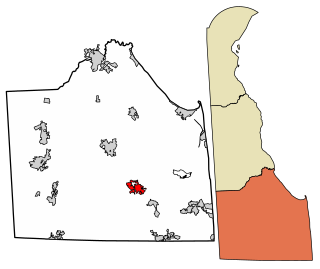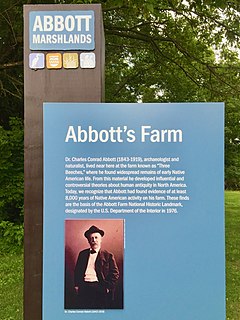Related Research Articles

Lewes is an incorporated city on the Delaware Bay in eastern Sussex County, Delaware, United States. According to the 2010 census, the population is 2,747. Along with neighboring Rehoboth Beach, Lewes is one of the principal cities of Delaware's rapidly growing Cape Region. The city lies within the Salisbury, Maryland–Delaware Metropolitan Statistical Area. Lewes proudly claims to be "The First Town in The First State."

Georgetown is a town in and the county seat of Sussex County, Delaware, United States. According to the 2010 census, the population of the town is 6,422, an increase of 38.3% over the previous decade.

Millsboro is a muncipality in Sussex County, Delaware, United States.

Seaford is a city located along the Nanticoke River in Sussex County, Delaware, United States. According to the 2010 Census Bureau figures, the population of the city is 6,928, an increase of 3.4% from the 2000 census. It is part of the Salisbury, Maryland-Delaware Metropolitan Statistical Area.

Aztalan State Park is a Wisconsin state park in the Town of Aztalan, Jefferson County, at latitude N 43° 4′ and longitude W 88° 52′. Established in 1952, it was designated a National Historic Landmark in 1964 and added to the National Register of Historic Places in 1966. The park covers 172 acres along the Crawfish River.

The Arkansas Post was the first European settlement in the lower Mississippi River Valley and present-day Arkansas. Henri de Tonti established it in 1686 as a French trading post on the lower Arkansas River. The French and Spanish traded with the Quapaw people for years.

This is a list of properties on the National Register of Historic Places in the U.S. state of Michigan.

The Abbott Farm Historic District is a National Historic Landmark archaeological site in New Jersey. It is the largest known Middle Woodland village of its type on the East Coast of the United States. Significant evidence suggests that the Delaware River floodplain was occupied by Paleoindian people for a long period. It was inhabited between 500 BC and 500 AD. It has been a source of controversy and debate around early development.

Minisink Archeological Site, also known as Minisink Historic District, is an archeological site of 1320 acres located in both Sussex County, New Jersey and Pike County, Pennsylvania. It was part of a region occupied by Munsee-speaking Lenape that extended from southern New York across northern New Jersey to northeastern Pennsylvania. The Munsee were speakers of one of the three major language dialects of the Lenape Native American tribe. This interstate territory became the most important Munsee community for the majority of the 17th and 18th centuries.

The Tobias-Thompson Complex, also known as the Little River Archeological District, is a complex of archaeological sites on the banks of the Little Arkansas River near Geneseo, Kansas, United States. The complex is an important set of sites that is one of the few in the region bridging the periods of prehistory and European contact, with a period of significance between 1500 and 1700 CE. It was designated a National Historic Landmark in 1964 and listed on the National Register of Historic Places in 1966.

This is a list of the National Register of Historic Places listings in Delaware County, Ohio.
The Vanderbilt Archeological Site is an archaeological site located on the shore of Lake Oahe in Campbell County, South Dakota, near Pollock, South Dakota. The site contains the remains of a Native American Plains village which has been tentatively dated to about 1300 AD. Despite the fact that site is subject to erosive destruction from wave action on the lake, has been determined likely to yield significant information about the movements and living patterns of prehistoric Native Americans in the region. The site was declared a National Historic Landmark in 1997.

Barton Village Site, also known as the Herman Barton Indian Village Archeological Site, is a large, multi-component archaeological site near Cumberland in Allegany County, Maryland.
The Portsmouth Earthworks are a large prehistoric mound complex constructed by the Ohio Hopewell culture mound builder indigenous peoples of eastern North America. The site was one of the largest earthwork ceremonial centers constructed by the Hopewell and is located at the confluence of the Scioto and Ohio Rivers, in present-day Ohio.

The C.H. Nash Museum at Chucalissa is located on and exhibits excavated materials of the Mississippian culture archaeological site known as Chucalissa which means "abandoned house" in Choctaw. The site is located adjacent to the T. O. Fuller State Park within the city of Memphis, Tennessee, United States. Chucalissa was designated National Historic Landmark in 1994 due to its importance as one of the best-preserved and major prehistoric settlement sites in the region.
Barnes Woods Archeological District is a national historic district located near Seaford, Sussex County, Delaware. The district includes four contributing sites. They are two small base camps and two procurement camps, representing a segment of the settlement system of Native American groups living in the Nanticoke River drainage between about 3000 B.C. and A.D. 1700.

The Nottoway Archeological Site is an overlapping series of prehistoric Native American settlement sites near the town of Stony Creek in Sussex County, Virginia. The site, located on a terrace above the Nottoway River, has documented evidence of occupation from c. 9200BCE to c. 1600. Finds at the site have included significantly stratified occupation features such as hearths, as well as large numbers of stone points and hide scrapers. It was, at the time of its listing in 1988, one of a small number of sites that shed light on Native American occupation of the interior coastal plain in the area.
Nununyi was a historic village of the Cherokee people in western North Carolina, located on the eastern side of the Oconaluftee River. Today it is within the boundaries of the present-day city of Cherokee in Swain County. It was classified by English traders and colonists as among the "Out Towns" of the Cherokee in this area east of the Appalachian Mountains.
Archeological Site No. 74-2 is a prehistoric site in Indian Island, Maine. Located on a terrace above the Penobscot River, the site dates to the Middle Archaic Period, a rarity in Maine, made even more unusual by the absence of later period artifacts. The site was listed on the National Register of Historic Places in 1984, for its potential to increase what is known about Native settlement patterns in the area.
References
- 1 2 "National Register Information System". National Register of Historic Places . National Park Service. July 9, 2010.
- ↑ Artusy, Richard (no date). National Register nomination for Indian River Archeological Complex; redacted copies available by request from the National Park Service